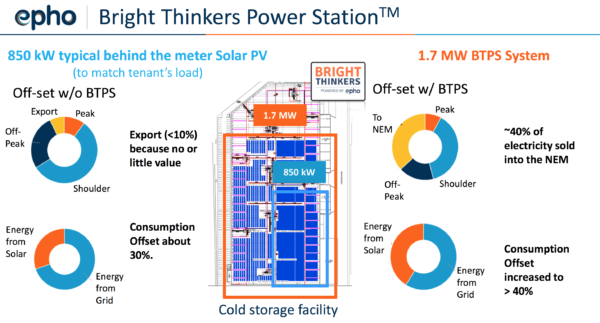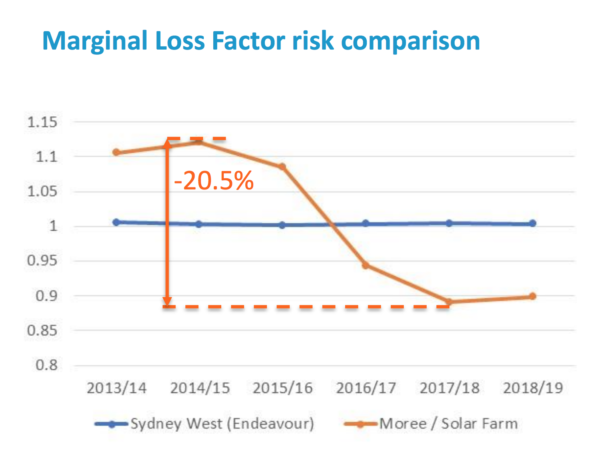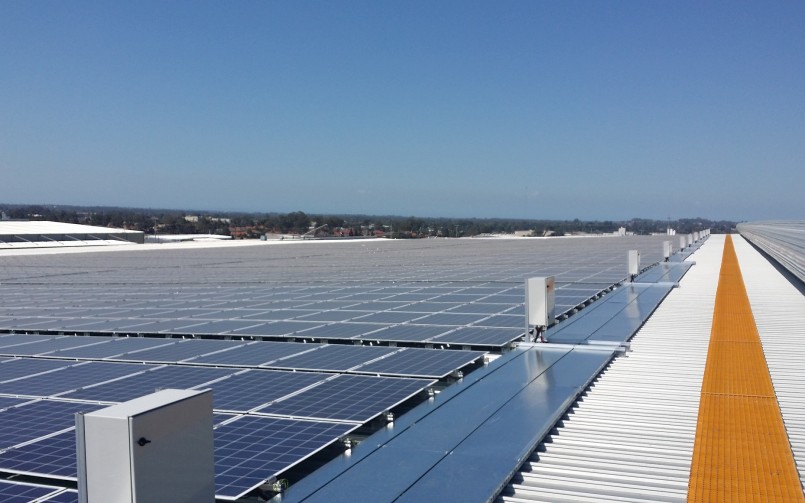Managing Director of Epho Commercial Solar, Dr Oliver Hartley, last week announced that after many consultations with AEMO and various energy service providers such as Ausgrid and Endeavour Energy, his company has evolved a solution for utilising the likely 50 GW solar potential of commercial and industrial rooftops in Australia.
Dubbed “Bright Thinkers Power Stations”, the model overcomes various constraints such as actual tenant requirements, the uncertainties of tenancy, and changes in energy retailers.
Among the concerns that prevent landlords from going big on their rooftop solar investment are: What if the building becomes vacant? What if onsite power consumption changes? What if the economics of the system relies on a feed-in tariff (FIT) and the occupant changes to a retailer that doesn’t offer an FIT?
When operating exclusively behind the meter, a large solar system can become a stranded asset under any of these scenarios.
Operating both behind and in front of the meter, as urban solar farms owned, built, maintained and administered by Epho, Bright Thinkers Power Stations allow landlords and property management companies to receive income from rental of their roof space, and to satisfy their own and their tenants’ sustainability goals and requirements.
Tenants benefit from long-term power purchase agreements that help them meet their energy needs from consistently low-cost onsite renewable sources.
Hartley illustrated Epho’s concept using an urban cold-storage facility as an example. The facility has in excess of 1.7 MW of solar-PV potential on its rooftop expanse, but the cold-storage business itself warrants installation of only 850 kW of generation. That’s enough to offset some 30% of its electricity bill and generate perhaps 10% excess energy, which may or may not be exported to the grid, depending on the solar-incentive scheme operating in that area.
“The nut we had to crack,” says Hartley, was, “How can the size of the solar system on an industrial building be decoupled from the occupants’ consumption?”

Image: Epho
Among the roadblocks were not only regulatory challenges, but technical and contractual challenges, which Epho has been negotiating and unravelling for a number of years.
“With our Bright Thinkers Power Station,” says Hartley, “Epho can put a 1.7 MW system on that roof space and deliver a much larger share of excess solar power to the National Electricity Market (NEM) as a market participant.” A larger system, capturing more energy in the mornings and afternoons can also increase the solar power available for onsite use to more than 40% of the cold-storage facility’s needs.
Epho’s forthcoming status as a registered participant in the NEM will allow it to flexibly respond to tenants’ needs, and to export what are often large excess capacities to the grid.
As generators with an aggregate supply of less than 30 MW, Bright Thinkers Power Stations could currently contribute to the NEM as “unscheduled” participants. That is, as an intermittent power supply their output would be accepted but not scheduled in AEMO’s co-ordinated dispatch process.
Hartley points out that the inclusion of battery storage in large rooftop solar systems would make their energy dispatchable, and that scheduled or semi-scheduled participation could then become a possibility. Epho would also have to produce aggregated dispatchable power in excess of 30 MW to achieve either scheduled or semi-scheduled grid-participation status — Hartley is optimistic.
Compared to utility-scale solar farms proposed for development on agricultural or unused land outside capital and regional cities, solar farms that rent their space on the rooftops of urban industrial, retail or large-scale residential developments have fewer hurdles to negotiate to reach approval stage, says Hartley.
“To develop a solar farm, you have a hydrology study, a geotechnical study, an environmental effects study and heritage and development approvals; as well as dealing with connection challenges and community engagement,” he says. In contrast, Hartley identifies the biggest challenges for industrial rooftop developments as structural — in particular whether the rooftops are capable of supporting solar panels and anchoring solar structures securely against local wind factors.
“There’s no real need for community engagement, and grid connection is simpler and quicker,” says Hartley. He adds that if the output of the rooftop solar farm is large enough, say from 3 MW to 4 MW of generation, and tenant electricity requirements are low, it may warrant installing a dedicated transformer for the site.
Proximity to grid connections and major consumers also reduces other risks associated with far-flung solar-farm development, such as marginal loss factors (MLFs) which can drain electricity from a developer’s bottom line, as energy is transmitted over distances where constantly changing load factors cause bottlenecks in often strained infrastructure.

Graph: Epho
Epho’s existing clients include global property managers such as Goodman, and supermarket chains such as Aldi. It gained recognition when it united the many stakeholders at Brisbane Airport to install 6 MW of solar across rooftops covering a total area across six separate sites that is greater than twice the size of the Melbourne Cricket Ground. Completed late last year this project now provides 18% of Brisbane Airport Corporation’s direct electricity use.
Epho’s first Bright Thinkers Power Station will be built in mid 2019, although the identity of participants currently remain under wraps.

Image: Epho
This content is protected by copyright and may not be reused. If you want to cooperate with us and would like to reuse some of our content, please contact: editors@pv-magazine.com.









5 comments
By submitting this form you agree to pv magazine using your data for the purposes of publishing your comment.
Your personal data will only be disclosed or otherwise transmitted to third parties for the purposes of spam filtering or if this is necessary for technical maintenance of the website. Any other transfer to third parties will not take place unless this is justified on the basis of applicable data protection regulations or if pv magazine is legally obliged to do so.
You may revoke this consent at any time with effect for the future, in which case your personal data will be deleted immediately. Otherwise, your data will be deleted if pv magazine has processed your request or the purpose of data storage is fulfilled.
Further information on data privacy can be found in our Data Protection Policy.